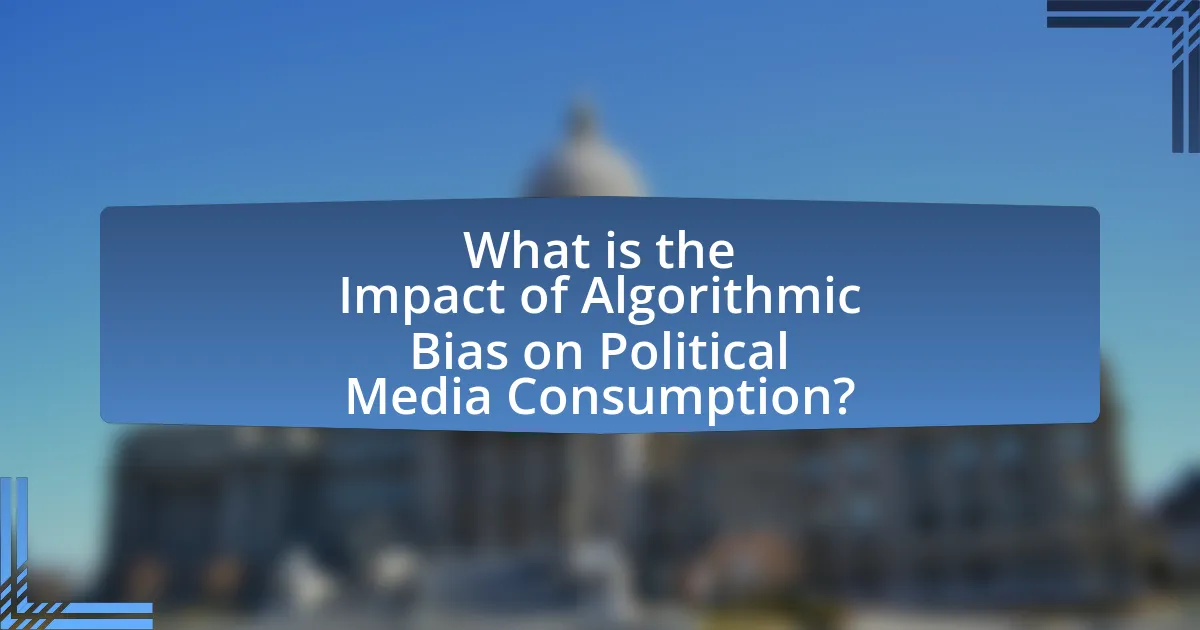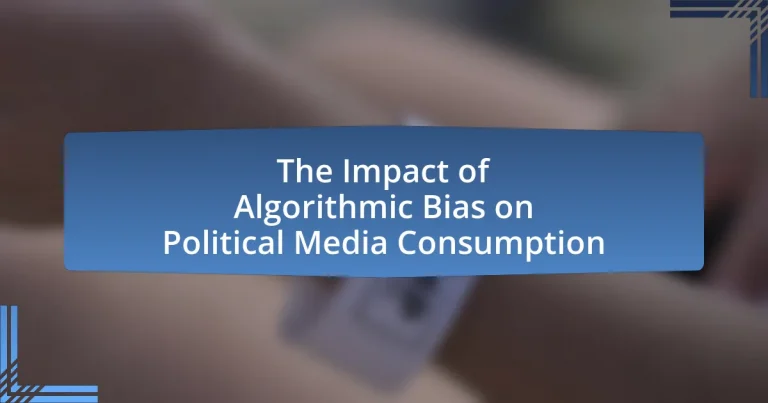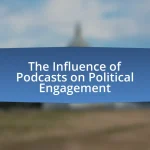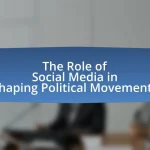The article examines the impact of algorithmic bias on political media consumption, highlighting how algorithms shape the information users encounter, often reinforcing existing beliefs and creating echo chambers. It discusses key factors contributing to algorithmic bias, such as data selection and user interaction patterns, and emphasizes the consequences of selective exposure on public opinion and political polarization. The article also explores strategies for mitigating algorithmic bias, including diversifying media intake and improving transparency in algorithmic processes, while providing best practices for critically evaluating politically influenced media.

What is the Impact of Algorithmic Bias on Political Media Consumption?
Algorithmic bias significantly influences political media consumption by shaping the information that users are exposed to, often reinforcing existing beliefs and creating echo chambers. This occurs because algorithms prioritize content based on user engagement metrics, which can lead to the amplification of partisan viewpoints while marginalizing diverse perspectives. Research by the Pew Research Center indicates that social media algorithms can create filter bubbles, where users predominantly see content that aligns with their political views, thus limiting exposure to opposing viewpoints. This selective exposure can distort public perception and contribute to polarization in political discourse.
How does algorithmic bias influence the way political media is consumed?
Algorithmic bias significantly influences the way political media is consumed by shaping the content that users are exposed to based on their previous interactions and preferences. This bias can lead to echo chambers, where individuals are primarily shown information that aligns with their existing beliefs, thereby reinforcing their viewpoints and limiting exposure to diverse perspectives. Research by the Pew Research Center indicates that 62% of Americans get their news from social media, where algorithms prioritize engagement over accuracy, often promoting sensational or polarizing content. This selective exposure can distort public perception and contribute to increased political polarization, as users become more entrenched in their ideologies without encountering opposing viewpoints.
What are the key factors contributing to algorithmic bias in media platforms?
Key factors contributing to algorithmic bias in media platforms include data selection, algorithm design, and user interaction patterns. Data selection often reflects historical biases, as datasets may over-represent certain demographics while under-representing others, leading to skewed outcomes. Algorithm design can introduce bias through the choice of features and optimization goals, which may prioritize engagement over fairness. User interaction patterns further exacerbate bias, as algorithms learn from user behavior that may be influenced by existing societal biases, creating a feedback loop that reinforces these biases. Studies, such as those by ProPublica, have shown that biased algorithms can lead to unequal treatment of different groups, highlighting the real-world implications of these factors.
How does algorithmic bias shape user preferences in political content?
Algorithmic bias shapes user preferences in political content by prioritizing certain viewpoints and narratives over others, leading to a skewed representation of political information. This occurs because algorithms, designed to maximize engagement, often favor content that aligns with users’ existing beliefs, creating echo chambers. Research by the Pew Research Center indicates that social media algorithms can significantly influence the political content users are exposed to, reinforcing their preferences and limiting exposure to diverse perspectives. Consequently, users may develop a more polarized view of political issues, as the algorithmic curation of content amplifies specific ideologies while marginalizing opposing viewpoints.
Why is understanding algorithmic bias important for political media consumers?
Understanding algorithmic bias is crucial for political media consumers because it directly influences the information they receive and shapes their perceptions of political issues. Algorithmic bias can lead to the amplification of certain viewpoints while suppressing others, resulting in a skewed understanding of political realities. For instance, research by the Pew Research Center indicates that social media algorithms often prioritize content that aligns with users’ existing beliefs, creating echo chambers that reinforce biases. This selective exposure can distort public opinion and hinder informed decision-making in democratic processes.
What are the potential consequences of algorithmic bias on public opinion?
Algorithmic bias can significantly distort public opinion by reinforcing existing stereotypes and creating echo chambers. When algorithms prioritize certain viewpoints or demographics, they can lead to a skewed representation of information, which influences how individuals perceive social issues and political events. For instance, a study by the Pew Research Center found that biased algorithms can exacerbate polarization by promoting content that aligns with users’ pre-existing beliefs, thereby limiting exposure to diverse perspectives. This selective exposure can result in a misinformed public, as individuals may develop opinions based on incomplete or biased information, ultimately affecting democratic processes and societal cohesion.
How can algorithmic bias affect the diversity of political viewpoints presented?
Algorithmic bias can significantly limit the diversity of political viewpoints presented by prioritizing certain perspectives over others based on user data and engagement metrics. This bias occurs when algorithms favor content that aligns with users’ previous interactions, leading to echo chambers where only similar viewpoints are amplified. Research by the Pew Research Center indicates that social media algorithms often reinforce existing beliefs, as users are more likely to engage with content that reflects their views, thus reducing exposure to opposing perspectives. Consequently, this selective exposure can skew public discourse and diminish the richness of political debate.
What role do social media algorithms play in political media consumption?
Social media algorithms significantly influence political media consumption by determining the visibility and accessibility of political content to users. These algorithms prioritize content based on user engagement metrics, such as likes, shares, and comments, which can lead to the amplification of certain political narratives while suppressing others. For instance, a study by the Pew Research Center found that 64% of Americans believe social media has a mostly negative effect on the way things are going in the country, indicating a perception that algorithms may contribute to polarization by favoring sensational or divisive content. Additionally, research published in the journal “Nature” highlights that algorithmic filtering can create echo chambers, where users are predominantly exposed to viewpoints that reinforce their existing beliefs, further shaping their political opinions and behaviors.
How do algorithms prioritize certain political content over others?
Algorithms prioritize certain political content over others primarily through engagement metrics, user behavior analysis, and content relevance. These algorithms analyze data such as likes, shares, comments, and viewing time to determine which political posts resonate most with users. For instance, platforms like Facebook and Twitter utilize machine learning models that adapt based on user interactions, promoting content that generates higher engagement rates. Research by the Pew Research Center indicates that algorithms can create echo chambers by favoring content that aligns with users’ existing beliefs, thereby influencing political media consumption patterns.
What impact do user interactions have on algorithmic recommendations?
User interactions significantly influence algorithmic recommendations by shaping the data that algorithms use to generate personalized content. When users engage with specific types of content—such as liking, sharing, or commenting—algorithms interpret these actions as indicators of preference, leading to a reinforcement of similar content in future recommendations. For instance, a study by the Pew Research Center found that 64% of Americans believe social media platforms have a significant impact on the news they see, highlighting how user engagement directly affects the visibility of political media. This interaction-driven feedback loop can create echo chambers, where users are repeatedly exposed to similar viewpoints, thereby amplifying algorithmic bias in political media consumption.
How can we mitigate the effects of algorithmic bias in political media consumption?
To mitigate the effects of algorithmic bias in political media consumption, implementing diverse data sets in algorithm training is essential. Diverse data sets ensure that algorithms are exposed to a wide range of perspectives, reducing the likelihood of reinforcing existing biases. Research indicates that algorithms trained on homogeneous data can lead to skewed representations, as seen in studies by ProPublica, which highlighted bias in predictive policing algorithms. Additionally, promoting transparency in algorithmic processes allows users to understand how content is curated, fostering accountability. Regular audits of algorithms can identify and rectify biases, as demonstrated by initiatives like the Algorithmic Accountability Act, which aims to require companies to assess their algorithms for fairness.
What strategies can consumers use to diversify their media intake?
Consumers can diversify their media intake by actively seeking out a variety of sources and formats. This includes subscribing to different news outlets, following diverse social media accounts, and engaging with content from various platforms such as podcasts, documentaries, and blogs. Research indicates that exposure to multiple viewpoints can mitigate the effects of algorithmic bias, which often narrows the range of information presented to users. For instance, a study by the Pew Research Center found that individuals who consume news from multiple sources are more likely to encounter differing perspectives, enhancing their understanding of complex issues.
How can media platforms improve transparency regarding their algorithms?
Media platforms can improve transparency regarding their algorithms by providing clear, accessible explanations of how their algorithms function and the criteria they use for content curation. For instance, platforms like Facebook and Google have begun to publish transparency reports that outline algorithmic changes and their impacts on user experience. These reports can include information on data sources, ranking factors, and the rationale behind algorithmic decisions, which helps users understand the processes that shape their media consumption. Additionally, implementing user-friendly tools that allow users to see why specific content is being recommended to them can further enhance transparency. Research from the Pew Research Center indicates that 70% of users express a desire for more insight into how algorithms influence their online experiences, highlighting the demand for such transparency measures.
What are the best practices for critically evaluating political media influenced by algorithms?
The best practices for critically evaluating political media influenced by algorithms include cross-referencing information from multiple reputable sources, analyzing the underlying algorithms for bias, and being aware of the echo chamber effect. Cross-referencing ensures that the information is corroborated by different perspectives, reducing the risk of misinformation. Analyzing algorithms involves understanding how they prioritize content, which can reveal biases that shape political narratives. Awareness of the echo chamber effect highlights the tendency for individuals to consume media that aligns with their existing beliefs, which can distort their understanding of political issues. These practices are essential for fostering informed political discourse in an algorithmically driven media landscape.


